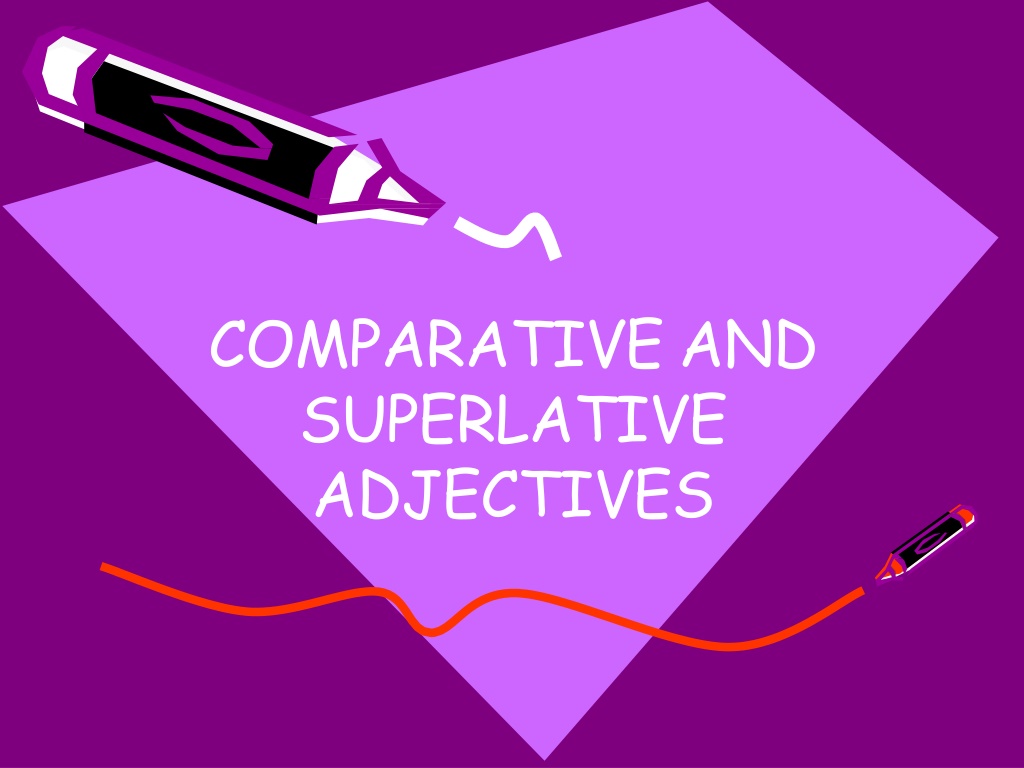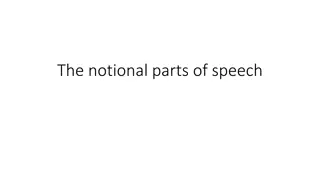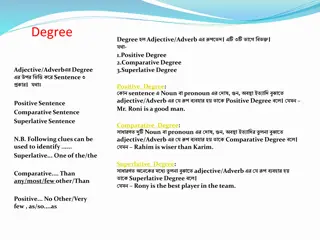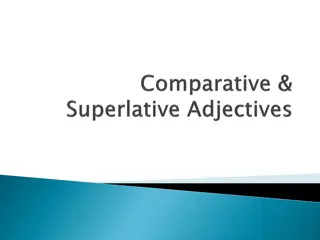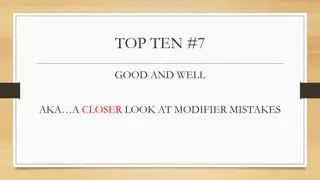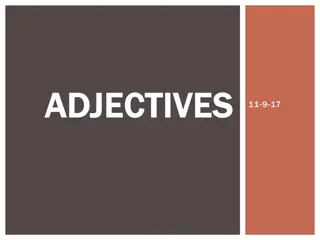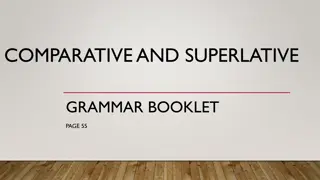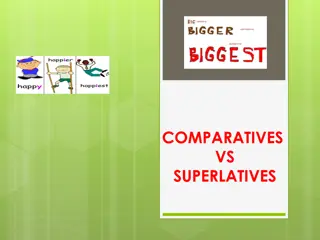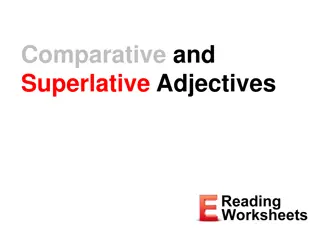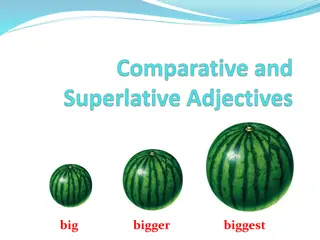Rules for Forming Comparative and Superlative Adjectives
Learn the rules for forming comparatives and superlatives of adjectives based on syllable count and endings. Understand the spelling conventions and exceptions for one, two, and three-syllable adjectives, as well as irregular adjectives. Master the comparative and superlative forms to enhance your English language skills effortlessly.
Download Presentation

Please find below an Image/Link to download the presentation.
The content on the website is provided AS IS for your information and personal use only. It may not be sold, licensed, or shared on other websites without obtaining consent from the author. Download presentation by click this link. If you encounter any issues during the download, it is possible that the publisher has removed the file from their server.
E N D
Presentation Transcript
COMPARATIVE AND SUPERLATIVE ADJECTIVES
SOME RULES ABOUT FORMING COMPARATIVES AND SUPERLATIVES One syllable adjectives generally form the comparative by adding -er and the superlative by adding -est, e.g.: Adjective Comparative Superlative Soft Softer Cheap Cheaper Sweet Sweeter Thin Thinner The softest The cheapest The sweetest The thinnest
SPELLING RULES Note that if a one syllable adjective ends in a single vowel letter followed by a single consonant letter, the consonant letter is doubled, e.g.: thin thinner, big biggest. If an adjective ends in -e, this is removed when adding -er/-est, e.g.: wide wider/widest. If an adjective ends in a consonant followed by -y, -y is replaced by -i when adding -er/-est, e.g.: dry drier/driest.
TWO SYLLABLE ADJECTIVES two syllable adjectives which end in -y usually form the comparative by adding -er and the superlative by adding -est, (note the change of-y to -i in the comparative/superlative) e.g.: Adjective Comparative superlative Lucky luckier The luckiest Pretty Tidy Prettier Tidier The prettiest The tidiest
TWO SYLLABLE ADJECTIVES two syllable adjectives ending in -ed, -ing, -ful, or -less always form the comparative with more and the superlative with the most, e.g.: Adjective Worried Comparative More worried superlative The most worried Boring More boring The most boring Careful More careful The most careful Useless More useless The most useless
THREE SYLLABLE ADJECTIVES Adjectives which have three or more syllables always form the comparative and superlative with MORE and THE MOST, e.g.: Adjective Comparative Superlative Dangerous More dangerous The most dangerous Difficult More difficult The most difficult The only exceptions are some three syllable adjectives which have been formed by adding the prefix -un to another adjective, especially those formed from an adjective ending in -y. These adjectives can form comparatives and superlatives by using more/most or adding -er/-est, e.g.: unhappy unhappier the unhappiest/ the most unhappy
IRREGULAR ADJECTIVES Adjective Comparative Superlative Good Better The best Bad Worse The worst Far Farther/further The farthest/furthest
USE OF COMPARATIVES Comparatives are very commonly followed by than and a pronoun or noun group, in order to describe who the other person or thing involved in the comparison is, e.g.: John is taller than me. I think that she s more intelligent than her sister.
OTHER USES OF COMPARATIVES Comparatives are often qualified by using words and phrases such as much, a lot, far, a bit/little, slightly etc., e.g.: You should go by train, it would be much cheaper. Could you be a bit quieter? I m feeling a lot better. Do you have one that s slightly bigger? Two comparatives can be contrasted by placing the before them,indicating that a change in one quality is linked to a change in another, e.g.: The smaller the gift, the easier it is to send. The more stressed you are, the worse it is for your health. Two comparatives can also be linked with and to show a continuing increase in a particular quality, e.g.: The sea was getting rougher and rougher. Her illness was becoming worse and worse. He became more and more tired as the weeks went by
USE OF SUPERLATIVES Like comparatives, superlatives can be placed before nouns in the attributive position, or occur after be and other link verbs, e.g.: the most delicious chocolate cake I ve ever eaten Annabel was the youngest This restaurant is the best As shown in the second two examples, superlatives are often used on their own if it is clear what or who is being compared. If you want to be specific about what you are comparing, you can do this with a noun, or a phrase beginning with in or of,e.g.: Annabel was the youngest child Annabel was the youngest of the children This restaurant is the best in town.
THE OPPOSITES OF COMPARATIVE AND SUPERLATIVES we use the forms less (the opposite of comparative more), and the least (the oppositeof superlative the most). Less is used to indicate that something or someone does not have as much of a particular quality as someone or something else, e.g.: This sofa is less comfortable. I ve always been less patient than my sister. The least is used to indicate that something or someone hasless of a quality than any other person or thing of its kind, e.g.: It s the least expensive way to travel. She was the least intelligent of the three sisters.
